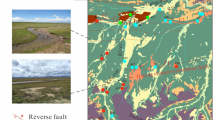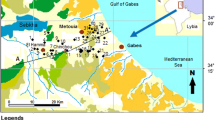Abstract
Groundwater is the primary source of drinking water for Kabul city residents, and it is also widely utilized for industrial and agricultural purposes. Identification of the major hydrogeochemical processes is significantly important for sustainable groundwater management in Western Kabul Plain (WKP) aquifer. In this research, the physicochemical results and isotopic ratios of water-stable isotopes of 13 groundwater and river water samples from the WKP were collected in April 2021 and employed to assess the hydrogeochemical processes using multivariate statistics and self-organizing map (SOM). The results of this study indicated that Ca–(Mg–Na)–HCO3 is the dominant type of hydro-chemical facies in the WKP aquifer. The findings revealed that all water samples originated from modern meteoric precipitation and the aquifer is mainly recharged from Kabul and Paghman rivers. The sampling locations were divided into three clusters based on Q-mode hierarchical cluster analysis and SOM models. The factor analysis and SOM models indicated that groundwater chemistry in the WKP aquifer is primarily controlled by the dissolution of calcite, dolomite, gypsum, halite, weathering of silicates, and ion exchange. The factor analysis and SOM models showed that NO3̄ concentrations principally originated from anthropogenic activities. The findings of this research may contribute to sustainable groundwater resource management in Kabul city.










Similar content being viewed by others
Data availability
The data supporting the findings of this research are available from the corresponding author upon reasonable request.
References
APHA/AWWA/WEF (2017) Standard methods for the examination of water and wastewater, 23rd edition. America Public Health Association, American Water Works Association, and Water Environment Federation, Washington, DC
Barzegar R, Moghaddam AA, Tziritis E, Fakhri MS, Soltani S (2017) Identification of hydrogeochemical processes and pollution sources of groundwater resources in the Marand plain, northwest of Iran. Environ Earth Sci 76:297. https://doi.org/10.1007/s12665-017-6612-y
Belkhiri L, Boudoukha A, Mouni L, Baouz T (2010) Application of multivariate statistical methods and inverse geochemical modeling for characterization of groundwater—a case study: Ain Azel plain (Algeria). Geoderma 159(3):390–398. https://doi.org/10.1016/j.geoderma.2010.08.016
Bohannon RG (2010) Geologic and topographic maps of the Kabul North 30′×60′ quadrangle, Afghanistan: U.S. Geological Survey Scientific Investigation Map 3120, 34 p. pamphlet, 2 map sheets, scale 1: 100,000. http://pubs.usgs.gov/sim/3120
Brati MQ, Ishihara MI, Higashi O (2019) Groundwater level, reduction and pollution in relation to household water management in Kabul, Afghanistan. Sustain Water Resour Manag 5:1315–1325. https://doi.org/10.1007/s40899-019-00312-7
Choi BY, Yun ST, Kim KH, Kim JW, Kim HM, Koh YK (2014) Hydrogeochemical interpretation of South Korean groundwater monitoring data using self-organizing map. J Geoch Expl 137:73–84. https://doi.org/10.1016/j.gexplo.2013.12.001
Clark ID (2015) Groundwater geochemistry and isotopes. CRC Press, New York
Farahmand A, Hussaini MS, Zaryab A, Aqili SW (2021) Evaluation of hydrogeoethics approach or sustainable management of groundwater resources in the upper Kabul sub-basin, Afghanistan. Sustain Water Resour Manag 7(48):8. https://doi.org/10.1007/s40899-021-00525-9
Giménez-Forcada E, Vega-Alegre M, Timón-Sanchez MS (2017) Characterization of regional cold-hydrothermal inflows enriched in arsenic and associated trace-elements in the southern part of the Duero Basin (Spain), by multivariate statistical analysis. Sci Total Environ 593–594:211–226. https://doi.org/10.1016/j.scitotenv.2017.03.071
Güler C, Thyne GD, McCray JE, Turner AK (2002) Evaluation of graphical and multivariate statistical methods for clarification of water chemistry data. Hydrogeol J 10:455–474
Hamidi MD, Kissane S, Bogush AA, Karim AQ, Sagintayev J, Towers S, Greenwell HC (2022) Spatial estimation of groundwater quality, hydrogeochemical investigation, and health impacts of shallow groundwater in Kabul city. Afghanistan Sustain Water Resour Manag 9:20. https://doi.org/10.1007/s40899-022-00808-9
Hommilius J, 1973. Hydrogeology and Geology of Kabul basin, Germany
Houben G, Tünnermeier T, Himmelsbach T (2005) Hydrogeology of the Kabul Basin—Part II: groundwater geochemistry and microbiology. Foreign Office of the Federal Republic of Germany, BGR, Hannover
Houben G, Tunnermeier T, Eqrar N, Himmelsbach T (2008) Hydrogeology of the Kabul Basin (Afghanistan), part II: groundwater geochemistry. Hydrogeol J 17:935–948. https://doi.org/10.1007/s10040-008-0375-1
Houben G, Niard N, Tunnermeier T, Himmelbach T (2009) Hydrogeology of the Kabul Basin (Afghanistan), part 1: aquifer and hydrology. Hydrogeol J 17(3):665–677. https://doi.org/10.1007/s10040-008-0377-z
Jawadi HA, Sagin J, Snow DD (2020) A detailed assessment of groundwater quality in the Kabul Basin, Afghanistan, and suitability for future development. Water 12:2890. https://doi.org/10.3390/w12102890
Ju Q, Liu Y, Hu Y, Wang Y, Liu Q, Wang Z (2020) Hydrogeochemical evolution and control mechanism of underground mulitiaquifer system in coal mine area. Geofluids. https://doi.org/10.1155/2020/8820650
Kohonen T (1982) Self-organized formation of topologically correct feature maps. Biol Cybern 43(1):59–69
Kohonen T, Somervuo P (2002) How to make large self-organizing maps for nonvectorial data. Neural Netw 15(8–9):945–952
Li J, Shi Z, Wang G, Liu F (2020) Evaluating spatiotemporal variations of groundwater quality in northeast Beijing by self-organizing map. Water 12:1382. https://doi.org/10.3390/w12051382
Liu P, Hoth N, Drebentedt C, Sun Y, Xu Z (2017) Hydro-geochemical paths of multi-layer groundwater system in coal mining regions—using multivariate statistics and geochemical modeling approaches. Sci Total Environ 601–602:1–14. https://doi.org/10.1016/j.scitotenv.2017.05.146
Mahaqi A, Mehiqi M, Moheghy MA, Moheghi MM, Hussainzadah J (2021) Nitrate pollution in Kabul water supplies, Afghanistan; sources and chemical reactions: a review. Int J. Environ Sci Technol. https://doi.org/10.1007/s13762-021-03551-4
Mahdawi Q, Sagin J, Absametov M, Zaryab A (2022) Water recharge suitability in Kabul aquifer system within the Upper Indus Basin. Water 14:2390. https://doi.org/10.3390/w14152390
Landell Mills (2020) Regional Groundwater Model. TA 8969 AFG: Kabul Managed Aquifer Recharge Project Preparation. Landell Mills, Kabul
Nassery HR, Alijani F (2014) The effects of an abandoned coal mine on groundwater quality in the science and research park (SRP) of Shahid Beheshti University, Zirab (Northern Iran). Mine Water Environ 33:266–275. https://doi.org/10.1007/s10230-014-0266-8
National Statistic and Information Authority (NSIA) (2021) Estimated population of Afghanistan 2020–2021. National Statistic and Information Authority, Kabul
Nejatijahromi Z, Nassery HR, Hosono T, Nakhaei M, Alijani F, Okumura A (2019) Groundwater nitrate contamination in an area using urban wastewaters for agricultural irrigation under arid climate condition, southeast of Tehran. Iran Agric Water Manag 221:397–414. https://doi.org/10.1016/j.agwat.2019.04.015
Noori AR, Singh SK (2021a) Status of groundwater resource potential and its quality at Kabul, Afghanistan: a review. Environ Earth Sci 80:654. https://doi.org/10.1007/s12665-021-09954-3
Noori AR, Singh SK (2021b) Spatial and temporal trend analysis of groundwater levels and regional groundwater drought assessment of Kabul Afghanistan. Environ Earth Sci 80:698. https://doi.org/10.1007/s12665-021-10005-0
Ouzerbane Z, Loulida S, Hmaidi AE, Essahhlaoui A, Boughalem M, Ousmana H, Berrada M (2021) Study of the salinity of groundwater in the HAHA syncline by the Kohonen self-organized classification (Essaouira, Morocco). Environ Sci Pollut Res. https://doi.org/10.1007/s11356-021-16598-0
Paiman Z, Noori AR (2019) Evaluation of wastewater collection and disposal in Kabul city and its environmental impacts. Modern Environ Sci Eng 5(5):451–458. https://doi.org/10.15341/mese(2333-2581)/05.05.2019/012
Panno SV, Hackley KC, Kelly WR, Hwang HH (2006) Isotopic evidence of nitrate sources and denitrification in the Mississippi River, Illinois. J Environ Qual 35(2):495–504
Parkhurst DL, Appelo CAJ (1999) User’s guide to PHREEQC (version 2): a computer program for speciation, batch-reaction, one-dimensional transport, and inverse geochemical calculations. Water-Resources Investig Rep 99(4259):312
Piper AM (1944) A graphic procedure in the geochemical interpretation of water-analyses. Trans AGU 25:914–928. https://doi.org/10.1029/tr025i006p00914
Qian JZ, Wang L, Ma L, Lu YH, Zhao WD, Zhang Y (2016) Multivariate statistical analysis of water chemistry in evaluating groundwater geochemical evolution and aquifer connectivity near a large coal mine, Anhui. China Environ Earth Sci 75(9):3–10. https://doi.org/10.1007/s12665-016-5541-5
Rozanski K, Araguas-Araguas L, Gofiantini R (1993) Isotopic patterns in modern global precipitation, in climate change in continental isotope records. American Geophysical Union, Geophysical Monograph 78
Saffi MH (2019) National alarming on groundwater natural storage depletion and water quality determination of Kabul city and immediate response to the drinking water crises. DACAAR, Kabul, pp 1–73
Shen H, Rao W, Tan H, Guo H, Ta W, Zhang X (2022) Controlling factors and health risks of groundwater chemistry in a typical alpine watershed based on machine learning methods. Sci Total Environ 854:158737. https://doi.org/10.1016/j.scitotenv.2022.158737
Stumm W, Morgan JJ (2012) Aquatic chemistry: chemical equilibria and rates in natural water, vol 126. Wiley, New York
Torres-Martinez JA, Mora A, Mahlknecht J, Kaown D, Barcelo D (2021) Determining nitrate and sulfate pollution sources and transformations in a coastal aquifer impacted by seawater intrusion a multi-isotopic approach combined with self-organized maps and a Bayesian mixing model. J Hazard Mater 417:126103. https://doi.org/10.1016/j.jhazmat.2021.126103
Tsuchihara T, Shirahata K, Ishida S, Yoshimoto S (2020) Application of a self-organizing map of isotopic and chemical data for the identification of groundwater recharge source in Nasunogahara alluvial fan. Japan Water 12:278. https://doi.org/10.3390/w12010278
Wafa W, Hairan MH, Waizy H (2020) The impacts of urbanization on Kabul city’s groundwater quality. IJAST 29(4):10796–10809
Ward JH (1963) Hierarchical grouping to optimize and objective function. J Am Stat Assoc. https://doi.org/10.2307/2282967
World Health Organization (2011) Guidelines for Drinking Water Quality. 4th Edition World Health Organization, Geneva, Switzerland. https://apps.who.int/iris/bitstream/10665/44584/1/9789241548151_eng.pdf
Yang Y, Liu H, Tang Z, Peeters L, Ye M (2022) Visualization of aqueous geochemical data using python and WQChartPy. Groundwater 60(4):555–564. https://doi.org/10.1111/gwat.13185
Zango MS, Pelig-Ba KB, Anim-Gyampo Gibrilla MA, Sunkari ED (2020) Hydrogeochemical and isotopic controls on the source of fluoride in groundwater within the Vea catchment, northeastern Ghana. Groundwater Sustain Develop 12:100526. https://doi.org/10.1016/j.gsd.2020.100526
Zaryab A, Noori AR, Wegerich K, Kløve B (2017) Assessment of water quality and quantity trends in Kabul aquifers with an outline for future drinking water supplies. CAJWR 3(2):3–11
Zaryab A, Nassery HR, Alijani F (2021a) Identifying sources of groundwater salinity and major hydrogeochemical processes in the lower Kabul Basin aquifer, Afghanistan. Environ Sci: Process Impacts 23:1589–1599. https://doi.org/10.1039/D1EM00262G
Zaryab A, Nassery HR, Alijani F (2021b) The effects of urbanization on the groundwater system of the Kabul shallow aquifers, Afghanistan. Hydrogeol J 30:429–443. https://doi.org/10.1007/s10040-021-02445-6
Zaryab A, Nassery HR, Knoeller K, Alijani F, Minet E (2022) Determining nitrate pollution sources in the Kabul Plain aquifer (Afghanistan) using stable isotopes and Bayesian stable isotope mixing model. Sci Total Environ 823:153749. https://doi.org/10.1016/j.scitotenv.2022.153749
Zaryab A, Farahmand A, Mack TJ (2023a) Identification and apportionment of groundwater nitrate sources in Chakari Plain (Afghanistan). Environ Geochem Health. https://doi.org/10.1007/s10653-023-01684-8
Zaryab A, Farahmand A, Nassery HR, Alijani F, Jamal MZ (2023b) Hydrogeochemical and isotopic evolution of groundwater in shallow and deep aquifers of the Kabul Plain, Afghanistan. Environ Geochem Health. https://doi.org/10.1007/s10653-023-01734-1
Zaryab A, Jamal MZ, Hussaini MS, Farahmand A, Ali, S (2023). Groundwater Environment and Management in Kabul, Afghanistan. In: Ali S, Armanuos AM (eds) Groundwater in Arid and Semi-Arid Areas. Earth Environ Sci Lib Springer, Chem. https://doi.org/10.1007/978-3-031-43348-1_10
Zhang H, Xu G, Chen X, Mabbaire A, Zhou J, Zhang J, Zhang Y, Zhang G, Zhu L (2020) Groundwater hydrogeochemical processes and the connectivity of multilayer aquifers in a coal mine with karst collapse columns. Mine Water Environ 39:356–368. https://doi.org/10.1007/s10230-020-00667-w
Acknowledgements
The author express sincere thanks to Kabul Polytechnic University and Green Tech Company for providing in situ measurement equipment. The authors are also great to six anonymous reviewers for their insightful comments and useful suggestions, which help to improve the manuscript.
Funding
This study did not receive any specific grant from funding agencies.
Author information
Authors and Affiliations
Contributions
Abdulhalim Zaryab: Conceptualization, Methodology, Formal analysis, Software, Resources, Data curation, Visualization, Writing—original draft, Writing—review and editing. Hamid Reza Nassery: Formal analysis, methodology, Supervision, Validation, Writing—review and editing. Farshad Alijani: Conceptualization, Methodology, Validation, Software, Visualization, Writing—review and editing. Kay Knoeller: Methodology, Formal analysis, Validation, Supervision, Writing—review and editing. All authors have read and approved the final version of the manuscript.
Corresponding author
Ethics declarations
Conflict of interest
The authors declare no conflict of interest.
Additional information
Publisher's Note
Springer Nature remains neutral with regard to jurisdictional claims in published maps and institutional affiliations.
Rights and permissions
Springer Nature or its licensor (e.g. a society or other partner) holds exclusive rights to this article under a publishing agreement with the author(s) or other rightsholder(s); author self-archiving of the accepted manuscript version of this article is solely governed by the terms of such publishing agreement and applicable law.
About this article
Cite this article
Zaryab, A., Nassery, H.R., Alijani, F. et al. Identification of hydro-chemical processes in Western Kabul Plain aquifer (Afghanistan) using statistical methods and self-organizing map. Sustain. Water Resour. Manag. 9, 198 (2023). https://doi.org/10.1007/s40899-023-00980-6
Received:
Accepted:
Published:
DOI: https://doi.org/10.1007/s40899-023-00980-6




